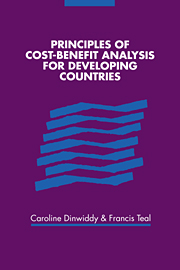Book contents
- Frontmatter
- Contents
- List of figures
- List of economic models and tables
- Preface
- Part I: Introduction to welfare economics
- Part II: Project and policy appraisal in developing countries
- Part III: Missing markets
- 12 Externalities and public goods
- 13 Risk and the measurement of welfare change
- 14 Natural resources and the environment
- Retrospect
- Bibliography
- Index
14 - Natural resources and the environment
Published online by Cambridge University Press: 22 October 2009
- Frontmatter
- Contents
- List of figures
- List of economic models and tables
- Preface
- Part I: Introduction to welfare economics
- Part II: Project and policy appraisal in developing countries
- Part III: Missing markets
- 12 Externalities and public goods
- 13 Risk and the measurement of welfare change
- 14 Natural resources and the environment
- Retrospect
- Bibliography
- Index
Summary
An aspect of cost-benefit analysis which has attracted widespread and growing interest over the last few decades concerns the social evaluation of economic activities which have either immediate or long-run consequences for the natural environment. The natural environment consists of a set of resources which can be conveniently divided into two categories: renewable resources for which the existing stock can be maintained by natural biological processes – for example, fish, trees, arable land, fresh air – and non-renewable resources, consisting primarily of mineral deposits and fossil fuels such as coal or oil. The stock of natural resources at any point in time will depend jointly upon the initial natural endowment (and in the case of renewable resources upon previous rates of reproduction) and on the past use that has been made of these resources by human beings in their economic roles as producers or consumers. Recent anxieties about the sustainability of the natural environment are based on the observation that the world's population has increased dramatically in the last century and with present growth rates will continue to double every forty-five years. This problem is intensified by the widespread desire not just to maintain, but to raise the standard of living of both present and future generations. These twin pressures on the available stock of natural resources have led people to wonder if there are ‘limits to growth’ (see Meadows et al., 1972, 1992); more specifically, the questions raised are whether the stock of non-renewable resources will soon be exhausted and whether those resources which are in principle renewable may also be exhausted if rates of extraction consistently exceed rates of natural regeneration.
- Type
- Chapter
- Information
- Principles of Cost-Benefit Analysis for Developing Countries , pp. 241 - 262Publisher: Cambridge University PressPrint publication year: 1996



